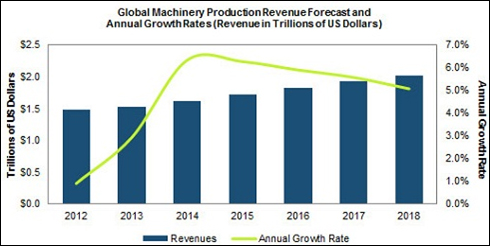Global plastics processing machinery demand is expected to advance 7% pa through 2017 to US$37.6 bln, with a healthier sales climate, resulting from accelerations in fixed investment spending and plastic resin consumption growth, will spur market gains through 2017, as per Freedonia’s industry study. Equipment utilized in the production of plastic packaged goods will expand at the fastest pace through 2017 and climb the most in absolute terms. Increases will be spurred by pickups in packaging demand and food and beverage manufacturing activity as living standards continue to rise in developing countries, stimulating greater consumption of packaged goods, particularly foods and beverages. Additionally, generally improved economic conditions in industrialized nations will lead to even higher packaging demand levels there. As a result, packaging will remain the largest single market for plastics processing machinery, followed in size by consumer/institutional products, construction, and other miscellaneous markets.
Injection molding equipment will continue to be the most popular product type, accounting for close to two-fifths of 2017 new machinery sales due to its versatility across a wide range of applications. However, demand for 3D plastics printers is expected to grow the fastest of any plastics processing equipment type from a relatively small current market base. 3D printers offer more flexibility in product design than traditional machines and will provide functional competition to injection molding equipment for custom-made parts, as well as in other low output and prototyping applications. In addition, advances in 3D printer technology and falling product prices will broaden the market for plastics processing machinery to include utilization by individual consumers, further bolstering demand. Extrusion machinery sales will climb at the next fastest rate, fueled by an increase in world construction activity.
Developing markets will provide the best growth opportunities for suppliers of plastics processing equipment through 2017. Central and South American sales will climb the most rapidly, led by the large and fast-rising Brazilian market, followed by the Africa/Mideast region, led by Turkey. China is currently by far the largest national equipment market, accounting for 29% of all 2012 sales, and it will continue to dominate global demand in 2017. India will be the fastest-growing national market, however, expanding over 12% pa. Rising personal incomes in these developing countries, leading to greater demand for plastic products, will be the primary driver of sales advances. The Asia/Pacific region will record the strongest plastics processing machinery shipment gains through 2017, led by China, which will account for 59% of total regional output. Not only will locally headquartered suppliers step up production, but many foreign multinationals will construct new or expand existing plants in Asia to reduce manufacturing and shipping costs and be closer to fast-growing customer bases there. Asia/Pacific industry output will also rise the most in dollar terms, as regional production expands from its already sizable base to account for half of worldwide equipment output in 2017.
High demand for machines in manufacturing sectors ranging from auto making to packaging will push the industrial machinery market to new heights during the next five years, highlighted by a doubling of growth this year, according to a report by IHS Technology. The study finds that economic conditions continue to improve worldwide and states that the demand for machines in sectors such as agriculture, packaging, materials handling and machine tools will push revenues to US$1.6 trillion this year, up from US$1.5 trillion in 2013. This represents annual growth of 6.3%, more than twice the 2.9% increase seen in 2013. IHS forecasts that growth will continue for the next four years, with revenue rising to US$2 trillion by 2018. During this period, the machinery market’s annual growth rate will remain quite impressive, averaging between 5% and 6%. |
The improving economic outlook is a key factor in the strong growth of machinery in the coming years,” said Andrew Robertson, senior analyst for industrial automation at IHS. “The growing populations and the expanding middle classes in developing countries are generating more disposable income. This translates into increased demand across a vast number of sectors.”
The report shows that the growth for the industrial machines in 2014 is being driven by several factors. First, higher demand for cars worldwide is spurring the requirement for more spending on tools and robotics in the automotive business, as well as the rubber and plastics segments. Meanwhile, an increase in the standard of living and growing spending on nutrition will benefit the food and packaging machinery sectors. Furthermore, rising spending on technology products will boost the demand for robotics, semiconductor equipment, mining, and oil and gas machinery. |


{{comment.DateTimeStampDisplay}}
{{comment.Comments}}